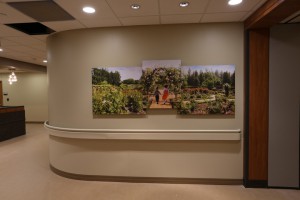Originally published by: Laura Landro, Wall Street Journal Aug. 18, 2014
Hospitals Are Giving Artwork a Higher Priority
Hospitals are turning to art as part of a broader push to create a healing environment as studies show that visual art can help reduce stress for patients and increase satisfaction with care. Dr. Iva Fattorini and Jennifer Finkel, who are both involved with art at the Cleveland Clinic, discuss on Lunch Break with Tanya Rivero.
Researchers are learning more about the precise ways paintings and other works of art help patients and families in the healing process. With studies showing a direct link between the content of images and the brain’s reaction to pain, stress, and anxiety, hospitals are considering and choosing artworks based on the evidence and giving it a higher priority than merely decoration for sterile rooms and corridors.
“These are not just accoutrements or aesthetics anymore,” says Lisa Harris, a nephrologist and chief executive of Eskenazi Health, affiliated with the Indiana University School of Medicine in Indianapolis.
With a $1.5 million budget from donors, she says, the health system commissioned 19 artists to create original works to support “the sense of optimism, vitality and energy” for the Sidney & Lois Eskenazi Hospital, which opened last December. “This is right down the fairway of what we need to be doing to promote health,” Dr. Harris says.
“Paths Crossed,” by Maine artist Aaron T. Stephan, is a large, spiraling wooden sculpture composed of six intertwined ladders suspended from the ceiling in the hospital’s two-story main concourse.
To Dr. Harris, it is a visual representation of the hospital’s approach to care, with “lives intertwined as we go from health to sickness and back to health again,” she says. People have reacted differently, she notes. “Some see it as DNA, and some see it as a roller coaster.”
Anne Berry, 81, says, “It makes me think of flying.” She visits the hospital for procedures and tests such as a mammogram and always takes time to look at the artworks. She has “white coat syndrome,” which makes her nervous about going to a doctor, but she says, “I have found the art and the environment at Eskenazi makes it less stress-inducing for me.”
Close to half of hospitals have arts programs, which include art therapy classes and musical performances, according to a 2009 report from the Society for Arts in Healthcare, now known as the Arts & Health Alliance.
Permanent art displays are most prevalent, and the trend continues to grow, says Steven Libman, outgoing executive director and now a consultant for the nonprofit.
Though many hospitals are in a budget crunch, funds for art are often provided by philanthropy, or built into construction budgets of new facilities.
For help with choosing art works, consultants, hospital curators and art committees turn to studies such as those gathered in the nonprofit Center for Health Design’s “Guide to Evidence-Based Art.”




